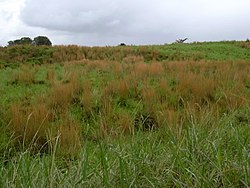| Andropogon | |
|---|---|
 | |
| Andropogon virginicus | |
| Scientific classification | |
| Kingdom: | Plantae |
| Clade: | Tracheophytes |
| Clade: | Angiosperms |
| Clade: | Monocots |
| Clade: | Commelinids |
| Order: | Poales |
| Family: | Poaceae |
| Subfamily: | Panicoideae |
| Supertribe: | Andropogonodae |
| Tribe: | Andropogoneae |
| Subtribe: | Andropogoninae |
| Genus: | Andropogon L. |
| Type species | |
| Andropogon distachyos | |
| Synonyms [3] | |
| |
Andropogon (common names: beard grass, bluestem grass, broomsedge) is a widespread genus of plants in the grass family, native to much of Asia, Africa, and the Americas, as well as Southern Europe and various oceanic islands. [4] [5] [6] [7] [8]
